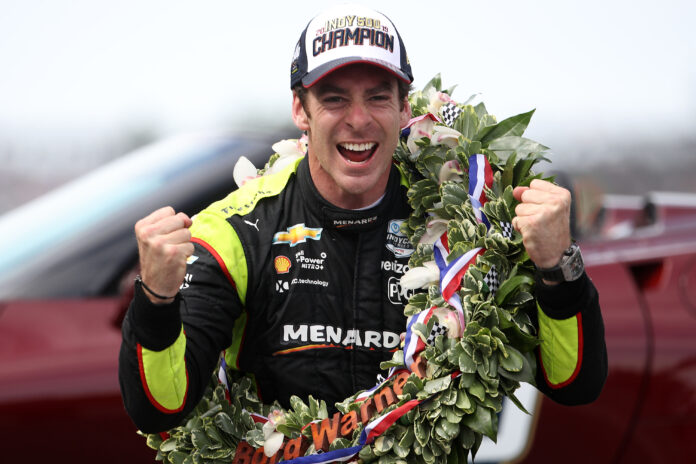The Indianapolis 500, often referred to as the “Indy 500,” is one of the most iconic and prestigious motorsport events in the world. Held annually at the Indianapolis Motor Speedway in Indianapolis, Indiana, this open-wheel racing spectacle is known for its rich history, thrilling competition, and cultural significance. With a history dating back to 1911, the Indianapolis 500 has become a symbol of American motorsport excellence and remains a must-see event for racing enthusiasts worldwide.
As we delve into the exhilarating world of the Indianapolis 500, it’s essential to acknowledge the significant role of Gainbridge, the presenting sponsor for the 103rd running of this iconic motorsport event. Gainbridge, a leading provider of annuities and life insurance, brings its own brand of excitement and support to this legendary race.
By partnering with the Indianapolis 500, Gainbridge underscores its commitment to excellence, innovation, and the pursuit of dreams—values that resonate deeply with the spirit of motorsport. As the presenting sponsor, Gainbridge adds an extra layer of prestige and anticipation to an event already steeped in tradition and excitement.
So, as we explore the heart-pounding moments and captivating stories of the 103rd running of the Indianapolis 500, let’s not forget the vital role that Gainbridge plays in making this event an unforgettable experience for racing enthusiasts worldwide. It’s a partnership that amplifies the excitement and anticipation as we immerse ourselves in the drama of the race and the history that surrounds it.
Historical Overview:
The history of the Indianapolis 500 is a tale of speed, innovation, triumph, and tragedy that has played out on the hallowed grounds of the Indianapolis Motor Speedway. Since its inception in 1911, this iconic motorsport event has etched its name into the annals of history, becoming one of the most significant and revered races in the world. Let’s journey through the decades to explore the rich history of the Indianapolis 500:
- 1911 – The Birth of a Legend:
- The inaugural Indianapolis 500 took place on May 30, 1911, at the newly constructed Indianapolis Motor Speedway. It was conceived as a daring experiment in speed and endurance.
- Ray Harroun, driving the Marmon Wasp, clinched victory in the first race. Harroun’s use of a rearview mirror, a pioneering innovation, earned him a unique place in racing history.
- 1912-1941 – Growing Pains and Golden Eras:
- The Indianapolis 500 quickly gained prominence, attracting top drivers and manufacturers from around the world.
- The 1920s and 1930s are often referred to as the Golden Era, with legendary drivers like Louis Meyer, Wilbur Shaw, and Bill Vukovich dominating the scene.
- Innovations, such as the introduction of the first rear-engine car by Frank Kurtis in 1941, marked this period.
- 1942-1945 – World War II Pause: The Indianapolis 500 took a hiatus during World War II, with the Speedway being used for military purposes. This break in racing only heightened anticipation for its return.
- 1946-Present – Modern Era and Milestones:
- The post-war period saw the Indianapolis 500 reemerge stronger than ever. Iconic drivers like A.J. Foyt, Mario Andretti, and Al Unser Sr. became household names.
- In 1961, A.J. Foyt became the first driver to win the race with a rear-engine car, revolutionizing the sport.
- The 1970s saw the dominance of the turbocharged Offenhauser engines, known for their distinctive roar.
- In 1977, Janet Guthrie made history as the first female driver to qualify and compete in the Indy 500.
- The 1980s and 1990s brought the era of high-tech, ground-effect cars and the emergence of names like Rick Mears and Emerson Fittipaldi.
- In 2000, Juan Pablo Montoya, a Formula 1 convert, won the Indy 500, showcasing the international appeal of the race.
- The 2010s witnessed a new generation of drivers, including Scott Dixon and Helio Castroneves, adding their names to the list of champions.
- In 2020, the Indianapolis 500 celebrated its 104th running, albeit with limited spectators due to the COVID-19 pandemic.
- Today – A Racing Icon:
- The Indianapolis 500 remains a beacon of speed, endurance, and innovation in the world of motorsports.
- It is the crown jewel of the IndyCar Series and an event that captivates millions of fans worldwide.
- The Indy 500 is not just a race; it’s a cultural phenomenon, featuring a festival atmosphere and traditions like the singing of “Back Home Again in Indiana.”
Race Day Details:
The 103rd running of the Indianapolis 500 took place at the historic Indianapolis Motor Speedway. Here are the essential details about this significant motorsport event:
- Date: The 103rd running of the Indianapolis 500 occurred on Sunday, May 26, 2019.
- Time: The race typically begins around 12:45 PM (local time), although the exact start time can vary slightly from year to year.
- Location: The event was held at the Indianapolis Motor Speedway in Speedway, Indiana. The Indianapolis Motor Speedway, often referred to as the “Brickyard,” is one of the most iconic and revered racing venues in the world, with a rich history dating back to its construction in 1909.
This race marked another chapter in the storied history of the Indianapolis 500, with top drivers and teams vying for the coveted Borg-Warner Trophy in front of a passionate and enthusiastic crowd of racing fans.
The Presenting Sponsor: Gainbridge:
Gainbridge’s involvement in the Indianapolis 500 as the presenting sponsor added a significant layer of prestige and excitement to this iconic motorsport event. Gainbridge, a leading provider of annuities and life insurance, stepped into the role of the presenting sponsor for the 103rd running of the Indianapolis 500 in 2019, showcasing its commitment to the world of racing and its dedication to supporting excellence and innovation.
Here are key aspects of Gainbridge’s involvement as the presenting sponsor:
- Name and Branding: As the presenting sponsor, Gainbridge’s name and branding were prominently featured alongside the Indianapolis 500 logo and marketing materials. This included extensive exposure on television broadcasts, race signage, and promotional materials.
- Enhancing the Event: Gainbridge’s presence helped enhance the prestige and excitement of the Indianapolis 500. The partnership between Gainbridge and the Indy 500 showcased the synergy between a forward-thinking financial services company and a historic motorsport event.
- Interaction with Fans: Gainbridge engaged with racing fans through various interactive experiences and activations. This allowed fans to connect with the brand and the event on a deeper level, creating memorable moments and experiences.
- Supporting Racing Excellence: By sponsoring the Indianapolis 500, Gainbridge aligned itself with the pursuit of excellence in motorsport. The race has a long history of attracting top drivers, teams, and innovations, and Gainbridge’s sponsorship underscored its commitment to supporting excellence and achievement.
- Celebrating Tradition: The Indianapolis 500 is steeped in tradition, and Gainbridge’s involvement allowed it to become a part of the rich history and culture of the race, while also contributing to its continued growth and evolution.
The Heroes of the Track:
Here are some of the most iconic drivers in the history of the Indianapolis 500:
- A.J. Foyt:
- A.J. Foyt is a true racing legend, and his impact on the Indianapolis 500 is immeasurable. He is the first driver to win the race four times (1961, 1964, 1967, 1977).
- Foyt’s versatility extended beyond the Indy 500; he was successful in various racing disciplines, including NASCAR and sports car racing.
- Mario Andretti:
- Mario Andretti’s win at the 1969 Indianapolis 500 remains a defining moment in his illustrious career. He is one of the few drivers to have achieved victories in Formula 1, IndyCar, and NASCAR.
- Andretti’s overall impact on motorsport, combined with his charismatic personality, makes him one of the sport’s most beloved figures.
- Rick Mears:
- Rick Mears is known for his smooth driving style and technical acumen. He claimed victory at the Indy 500 four times (1979, 1984, 1988, 1991).
- Mears’ expertise in oval racing and meticulous approach to the sport earned him a place among the all-time greats.
- Wilbur Shaw:
- Wilbur Shaw secured back-to-back Indianapolis 500 wins in 1939 and 1940. His influence extended beyond his driving skills; he also served as the president of the Indianapolis Motor Speedway.
- Shaw’s contributions to the race and the sport’s development were monumental.
- Helio Castroneves:
- Helio Castroneves made history by becoming one of only four drivers to win the Indianapolis 500 four times (2001, 2002, 2009, 2021). His exuberance and charisma have endeared him to fans.
- Castroneves’s unique ability to excel on the biggest stage earned him a place among the greatest drivers of the modern era.
Safety Measures and Regulations:
Here are the key safety measures and recent innovations in place:
- Vehicle Safety:
- Vehicle design remains a cornerstone of safety. IndyCar Series cars are constructed with advanced materials, including carbon fiber and energy-absorbing components, to protect drivers.
- The introduction of the Advanced Frontal Protection (AFP) device in 2019 provided additional head protection for drivers, serving as a deflector in front of the cockpit.
- Helmets and Gear:
- Drivers wear high-tech helmets equipped with the latest safety features, including reinforced shells and energy-absorbing liners.
- Fire-resistant suits, gloves, and footwear provide protection in case of fire.
- Head and Neck Restraints: The use of head and neck restraint systems (HANS devices) is mandatory. These devices reduce the risk of head and neck injuries during crashes.
- Cockpit Safety: Although IndyCars maintain open-cockpit designs, the introduction of canopies and closed cockpits is under consideration to further enhance driver safety.
- Soft Walls and Barriers:
- The SAFER Barrier system, introduced in the early 2000s, consists of energy-absorbing materials installed along the track walls to reduce the force of impacts.
- Tire barriers are used at various locations around the track to provide additional energy absorption during crashes.
- Fire Safety:
- Cars are equipped with onboard fire extinguishers that can be activated by the driver in case of fire.
- Fueling procedures are controlled to minimize the risk of fuel-related fires during pit stops.
- Medical Response:
- Dedicated medical teams are present at the track with specialized training in motorsport injuries.
- Life-saving equipment is readily available, and ambulances are strategically stationed.
- Speed Limits in Pit Lane: Strict speed limits are enforced in the pit lane to prevent accidents during pit stops.
- Catch Fences and Spectator Safety:
- Catch fences are designed to keep debris from leaving the track in case of accidents.
- Spectator areas are equipped with fencing and barriers to protect fans from potential incidents.
- Weather Monitoring: Weather conditions are continuously monitored, and races can be delayed or halted in adverse weather to ensure safety.
- Driver Education and Training: Drivers undergo extensive training on safety protocols and cockpit escape procedures.
Recent Rule Changes and Innovations:
- In recent years, there has been a focus on improving head protection for drivers. The introduction of the AFP device was a notable step in this direction.
- The continued development of the Aeroscreen, a protective canopy-like structure, represents a significant innovation aimed at enhancing driver safety. It was introduced in the 2020 IndyCar season and has since become a standard feature.
- Rule changes have also addressed issues such as driver behavior on restarts and track limits to mitigate potential incidents.
Conclusion:
In conclusion, the 103rd running of the Indianapolis 500 presented by Gainbridge was an exhilarating and historic event in the world of motorsport. Held at the iconic Indianapolis Motor Speedway, it showcased the skill, determination, and passion of the drivers as they competed in the “Greatest Spectacle in Racing.” With a rich legacy dating back over a century, this event continues to captivate fans worldwide and remains a testament to the enduring spirit of competition and speed. Each edition of the Indy 500 adds a new chapter to its storied history, and the 103rd running was no exception, leaving fans eagerly anticipating the next thrilling installment in this legendary race.







